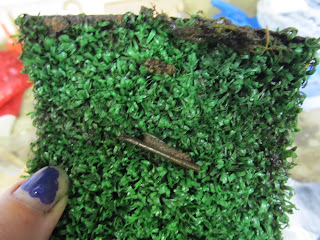 |
| Sorting inverts to Opeth |
The rolled up astroturf provides a great little shelter for all sorts of beasties to make their homes in to escape from predators. Among the rafts of caddisfly larvae there were also water fleas, diptera larvae (more commonly known as bloodworms), the odd small leech, one gammerus (freshwater shrimp), mites and some teeny tiny black beetles. Some required a little persuasion to get between the ends of my forceps and into the tube!
 |
| Caddis case with a glorious surrounding lawn! |
Among all the usual suspects there was a large flying insect which seemed happy rowing along in the water, but myself and my housemates had some difficulty trying to identify. However, rather than being some amazing bog beast new to science it turned out to be a half-hatched caddisfly...you live and learn!
 |
| The beast of Clar loch |
On Monday I was back in the woods doing dipwell surveys again and I'll be doing the same tomorrow and Friday, hopefully avoiding getting stuck or losing a welly in the boggy pools this time!
Today was quite exciting as the team were getting some training from Colin Bean at SNH in how to carrying out fish surveys in the loch using gill and seine netting. The aim is to catch, mark (by snipping off a little bit of the fish's adipose fin) and then release so that the RSPB can get an idea of the fish populations of the lochs. This is to assess how much impact the fish might have on the food web of invertebrates and the Common Scoters. We had a couple of non-starters with the netting at first but then we hit the jackpot, and hopefully once my camera has dried out I'll tell you all about it next time.
No comments:
Post a Comment